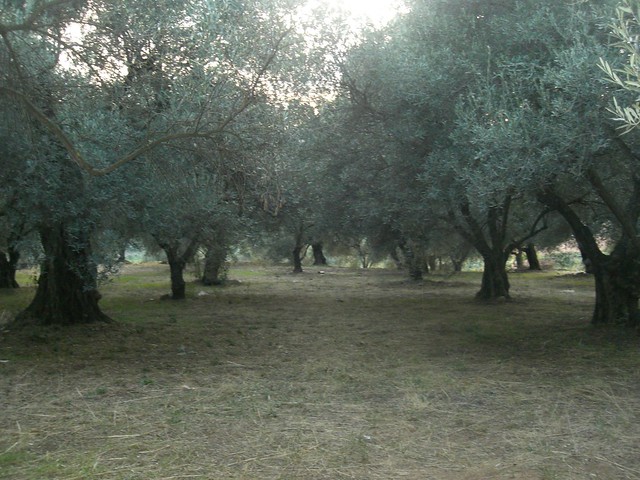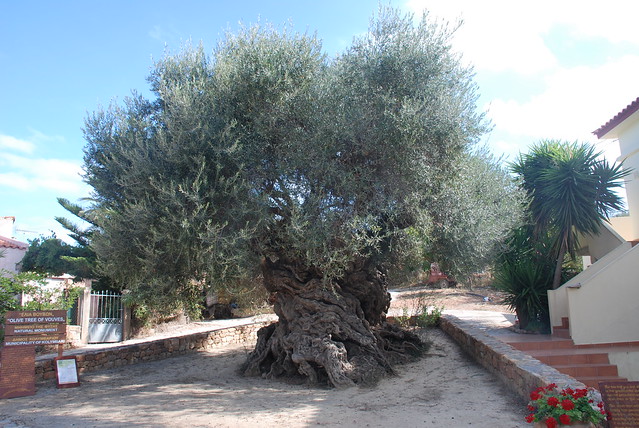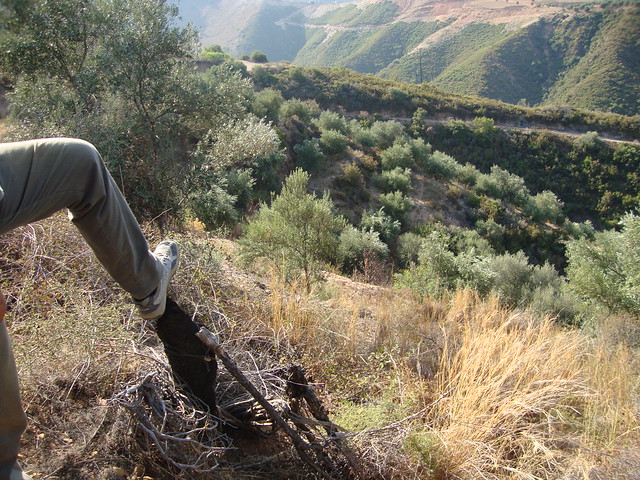We've had a long spell of very cold weather in Hania. Our wood-fired heater is working every day to keep us warm. This means that the oven compartment is always working. There is now so much free cooking heat which means I don't have to keep relying on the whims and fancies of the Greek public power corporation, the infamous DEH.
The DEH bill was where the new property tax was added, in order to be collected. Those who didn't pay itwere threatened with disconnections (something I haven't seen being done yet in Hania among those of my acquaintances who insisted that they will not pay). A rise in the cost of electricity was recently announced, put into effect this month, which will be reflected in our next bill. DEH also has one of the most powerful worker's unions in the country, so when DEH decides to strike, the disruptions are felt everywhere.
We've always used gas for cooking on an element, but DEH has always powered my oven, until just recently when the wood-fired oven began working. For the winter at least, I won't have to worry about not having an oven to work with. I don't have to worry about not being able to cook my culinary creations when there is no power. We can heat both ourselves and our food with more sustainable forms of energy.
But firewood isn't free, nor is it cheap, even when you have your own supplies. It's just like the olive oil Cretans produce from their fields: that's not free or cheap either. To produce your own olive oil, you need to give up a lot of your own time and use up a lot of your own energy by laying nets, thrashing branches, gathering the olives, sifting them to get rid of the leaves and twigs, sacking them, taking them to the olive mill, gathering the oil into containers that you can carry to your home and filling up your coffers with it.
Most people working in another job during the day (like us) don't have time to harvest their olive crop on their own, so they hire someone else to do all this work for them (these people are nearly always Albanians). If they have a suitable vehicle, they just pick up the sacks full of olives and take them to the mill to pick up the oil that is produced from them. The people who did the job for them are paid according to the harvest - they get about 40% of the oil (which they can take home for their own use, or they can leave it at the olive press and be paid for it), the olive mill gets about 10% of the oil (for the work they did to produce the oil) and the owner of the field gets the remaining 50%. One litre of olive oil costs a litre of olive oil to produce. At the moment, Greek mills are paying out about 2 euro per litre. If you are paying less than that for the olive oil you are buying in a country that doesn't produce olive oil for its own supplies, then you can guarantee that someone else is suffering.
Our firewood comes from our own fields. The olive trees need annual trimming to maintain them with an umbrella-like shape, which makes it easier to harvest the crop. The umbrella shape also keeps the tree healthy, allowing it to 'breathe'. If the canopy of the tree is too dense, the tree will harbour a lot of insects amidst its branches, notably the Mediterranean dakos fly which favours olive trees, and the oil produced from dakos-infected crop will not be of a very high quality, as dakos infestation rasies the acidity level, ie the olive oil risks losing its extra virgin quality.
To collect the firewood, you need your own appropriate vehicle; to run your own vehicle, you need diesel fuel; to buy diesel fuel, you need money - it can't be bought any other way in Greece. And once you bring your firewood home, you need to chop it into small enough pieces that fit into your fireplace or wood-fired heater. If you don't have the appropriate tools to cut your wood into suitably sized pieces, your arms are going to hurt a lot (my husband was off work for a week due to an inflammation in his shoulder - he couldn't change gears or turn the sterring wheel).

There's no such thing as a free lunch.
©All
Rights Reserved/Organically cooked. No part of this blog may be
reproduced and/or copied by any means without prior consent from Maria
Verivaki.
The DEH bill was where the new property tax was added, in order to be collected. Those who didn't pay itwere threatened with disconnections (something I haven't seen being done yet in Hania among those of my acquaintances who insisted that they will not pay). A rise in the cost of electricity was recently announced, put into effect this month, which will be reflected in our next bill. DEH also has one of the most powerful worker's unions in the country, so when DEH decides to strike, the disruptions are felt everywhere.
An olive grove after the harvest: the nets are lifted, the field is cleared of branches and the weeds are mulched for organic manure.
We've always used gas for cooking on an element, but DEH has always powered my oven, until just recently when the wood-fired oven began working. For the winter at least, I won't have to worry about not having an oven to work with. I don't have to worry about not being able to cook my culinary creations when there is no power. We can heat both ourselves and our food with more sustainable forms of energy.
But firewood isn't free, nor is it cheap, even when you have your own supplies. It's just like the olive oil Cretans produce from their fields: that's not free or cheap either. To produce your own olive oil, you need to give up a lot of your own time and use up a lot of your own energy by laying nets, thrashing branches, gathering the olives, sifting them to get rid of the leaves and twigs, sacking them, taking them to the olive mill, gathering the oil into containers that you can carry to your home and filling up your coffers with it.
Most people working in another job during the day (like us) don't have time to harvest their olive crop on their own, so they hire someone else to do all this work for them (these people are nearly always Albanians). If they have a suitable vehicle, they just pick up the sacks full of olives and take them to the mill to pick up the oil that is produced from them. The people who did the job for them are paid according to the harvest - they get about 40% of the oil (which they can take home for their own use, or they can leave it at the olive press and be paid for it), the olive mill gets about 10% of the oil (for the work they did to produce the oil) and the owner of the field gets the remaining 50%. One litre of olive oil costs a litre of olive oil to produce. At the moment, Greek mills are paying out about 2 euro per litre. If you are paying less than that for the olive oil you are buying in a country that doesn't produce olive oil for its own supplies, then you can guarantee that someone else is suffering.
This olive tree is believed to be the oldest olive tree in the world - and it's found here in Hania.
Our firewood comes from our own fields. The olive trees need annual trimming to maintain them with an umbrella-like shape, which makes it easier to harvest the crop. The umbrella shape also keeps the tree healthy, allowing it to 'breathe'. If the canopy of the tree is too dense, the tree will harbour a lot of insects amidst its branches, notably the Mediterranean dakos fly which favours olive trees, and the oil produced from dakos-infected crop will not be of a very high quality, as dakos infestation rasies the acidity level, ie the olive oil risks losing its extra virgin quality.
An olive grove located on a mountain slope, which makes harvesting very difficult. Most olive groves in Crete are located on slopes.

Our supplies oif firewood are as plentiful as the energy required to gather the wood and chop it. If worse gets to worst, and we can't afford to buy engine fuel, we won't be able to bring it home.
*** *** ***
Using our own supplies of olive oil and firewood, I made these delicious chocolate lava pots. The recipe was based on a French one in Lunch in Paris by Elisabeth Bard, using butter and a conventional oven. But everything that requires butter can also be made with olive oil, as I've shown in other recipes. Even if you don't have a temperature gauge on your wood-fired oven, you can learn to gauge the heat, so that you can work out if something has been cooked and is ready to eat. You also need to know what the final product must look like.


You need:
8 tablespoons of extra virgin olive oil (use some good stuff - low quality olive oil may have a bad odour or rancid taste, which will ruin the final taste)
200g cooking chocolate (I used the 55% variety - Greeks generally don't like their chocolate too bitter)
a pinch of sea salt (even though I added just a few grains, my kids could taste it - 'don't add it next time, Mum')
3 eggs (or 2 eggs and 2 yolks - my version is more economical)
1/2 cup sugar
2 tablespoons of flour
Melt the chocolate in the olive oil on very low heat (you won't need a double boiler). Add the salt and stir it in. Put the chocolate mixture aside. In another bowl, beat all the eggs with the sugar until light and fluffy looking. Add the egg mixture to the (slightly cooled down) chocolate, and mix it in well. The result will look like a thick gooey batter. Then add the flour and mix it in evenly, but lightly, careful not to overmix.




I used an old metal baking tin to place in the oven. I'm afriad that my purex and ceramic dishes might crack if I place them in the oven without some form of protection. Metal tins may warp and discolour, but they don't break.
Pour the batter into 6 ramekins. If you want to remove the cooked deserts from the ramekins before serving, you need to grease them first. I served them straight from the ramekins, but some people may prefer to place them on a decorative plate and pour some cream over the desert - but I've had the same desert at Pizza Hit in Iraklio, and it was served in the ramekin, with pouring cream on the side.
To cook the ramekins in a wood-fired oven, place them in a baking tin to which you've added two centimetres of water. To check the temperature of the oven, open it and place your hand insde the cmpartment, carefully so that you don't touch the walls. Ask yourself: 'does it feel warm?' or 'does it feel hot?' or 'does it feel very hot?' If it feels too hot to even leave your hand in for two seconds, that means that the oven will burn whatever you put it in it. (It's happened to me once, with a cake.) For the chocolate lava pots, you want the oven to feel 'very hot'.


Definitely done - the one that lost its shape looks as though its centre is gooey.
Place the tin holding the ramekins in the oven compartment of your wood-fired oven (this ensures that even when the oven is too hot, the lava pots won't burn). The chocolate pots will need no more than 10 minutes to be ready. You will realise that they are cooking correctly when you see the water in the tin boiling away. Not only that, but you will also see the chocolate pots rising slightly, and creating a cracked crust on the top. When you think they are done, take them out of the oven to test them for doneness. NB: don't touch anything with bare hands - the tin and the ramekins and the water will be at burning point! Use you finger to press the top of one of the chocolate pots. If it looks like a biscuit on the top and feel like a cake when you press it, then it's ready.

Allow the lava pots to cool down enough to allow you to handle them. You can cool them down more quickly by pouring some cold water in the tin. Enjoy your chocolate pots 'neat', or with some cream or ice-cream or dried fruit and nuts, or even some Greek spoon sweets, in the same way as depicted in the Greek-style custard pies I made recently.
This poverty thing doesn't mean you can't have your cake or eat it.

My chocolate lava pots could have done with less cooking time - it all depends on how molten you want the interior to be.
This poverty thing doesn't mean you can't have your cake or eat it.



Whenever my daughter is having a craving for something sweet she makes lava cakes! They fit the craving nicely.
ReplyDeleteΜαρία τελευταία έχεις γράψει πολύ ενδιαφέροντα ποστ, τα οποία διάβασα μαζεμένα σήμερα! Δεν σε προλαβαίνω!
ReplyDeleteΣχολιάζω γενικώς λοιπόν. Πράγματι το να μπορείς να αντικαταστήσεις το βούτυρο με ελαιόλαδο είναι ό,τι καλύτερο! Η τελευταία μόδα που επικρατεί εδώ, είναι να κλέβουν τα σακιά με τις ελιές, αν τα αφήσεις τη νύχτα στο χωράφι και δεν τα πάρεις! Κρίση παντού βλέπεις!
Πιστεύω ότι το μαγείρεμα σε ξυλόφουρνο κάνει πάρα πολύ ωραία φαγητά (και προφανώς γλυκά), αρκεί να μάθεις τα χούγια του κι εσύ όπως φαίνεται τα έμαθες καλά!
¨οπως δείχνει το πράγμα, πολλοί θα στραφούν στις ξυλόσομπες λόγω κρίσης, όμως φοβάμαι, ότι και οι σόμπες θα ανεβούν, και τα ξύλα θα ανεβούν και σε λίγο δεν θα ξέρουμε τι να κάψουμε. Άλλωστε, βλέπεις πόσο εύκολα και γρήγορα καίγονται τα ξύλα, σωστά; Μακάρι να έρθουν καλύτερες μέρες για όλους!
Συνέχισε τα ωραία και ενδιαφέροντα ποστ!
οπως τα λες ειναι, κικη - δεν μου κανει εντυπωση πως τα σακια εξαφανιζονται, και δεν ξερουμε ακομα ποσο θα κρατησει αυτη η κατασταση...
ReplyDeleteYour wood stove is wonderful Maria. My grandmother was good at cooking on one, but I"ve never tried. We have an electric stove now, but I prefer cooking with gas - but either one is very expensive.
ReplyDeleteYour chocolate pots look so delicious. Chocolate is always good.
Hi Maria, this is such an interesting post and an easy and delicious lava cake recipe!Hope you'll have a great day!
ReplyDelete